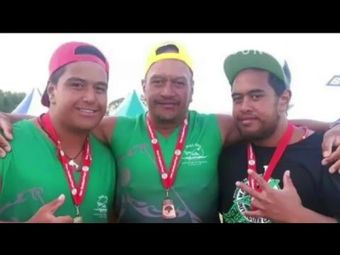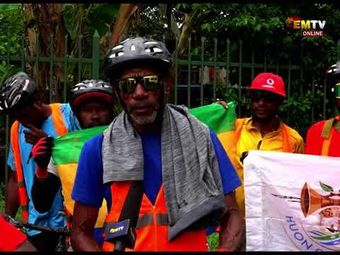Monaŋ ‘Paddle’
- Description:
- The Awiakay paddle upriver and into the smaller creeks to go fishing, or to their bushcamps to hunt or to process sago. A paddle is therefore used on a daily basis. While the Awiakay’s downriver neighbours, the Ambonwari, have differently shaped male and female paddles, the Awiakay do not make such a distinction either in naming paddles, nor in their shape. The only difference between Awiakay paddles is in their length; a shorter one is usually used by a woman who sits in the back of the canoe, whereas the man who steers the canoe is standing in the front, using a longer paddle. Awiakay paddles are not as exquisitely carved or decorated as are those of their downriver neighbours, the Karawari and the Sepik people, but are modestly carved at the top. However, along with killing a pig and making a clearing for a garden, making his own paddle used to be considered important for any young man who was about to get married. While this string figure is called ’a paddle’ it actually represents the action of paddling. When the design is finished, the maker invariably starts ‘paddling’ with it, marking the function of this object. Images: 02: Darja Munbaŋgoapik showing the final design of monaŋ ‘a paddle’ 03: monaŋ ‘a paddle’ . Language as given: Awiakay. You can access this item at the PARADISEC website. You will need to sign up or sign in first.
- Format:
- MovingImage
- Collections:
- PARADISEC Catalog
- Contributors:
- Darja Hoenigman
- Content partner:
- PARADISEC
- Availability:
- Not specified
-
Copyright status: All rights reservedFind out more about what you are able to do with this itemThis item is all rights reserved, with means you'll have to get permission from PARADISEC before using it. For more information, please see our use and reuse page.More informationPARADISEC has this to say about the rights status of this item:
Open (subject to agreeing to PDSC access conditions)
What can I do with this item?Non-infringing useNZ copyright law does not prevent every use of a copyright work, and this item may be hosted by an international institute or organisation. You should consider what you can and cannot do with a copyright work.No sharingYou may not copy and/or share this item with others without further permission. This includes posting it on your blog, using it in a presentation, or any other public use.No modifyingYou are not allowed to adapt or remix this item into any other works.No commercial useYou may not use this item commercially.
Welcome and warm Pasifik greetings
The information on this site has been gathered from our content partners.
The names, terms, and labels that we present on the site may contain images or voices of deceased persons and may also reflect the bias, norms, and perspective of the period of time in which they were created. We accept that these may not be appropriate today.
If you have any concerns or questions about an item, please contact us.


